Jingle Cats
If you were listening to the radio in the 90s, or got a certain flavour of email forward, there's a good chance you've heard the song Jingle Cats. The original novelty single from 1993 is exactly what it sounds like—pitch-bent cat meows set to music to create the illusion cats are "singing" Jingle Bells. It was an absolutely huge hit and, between 1993 and 2009, led to the release of four full albums along with "Jingle Dogs" and "Jingle Babies" spinoffs[1]. Exciting stuff, surely. The empire extended to merchandise, and, somehow, a video game.
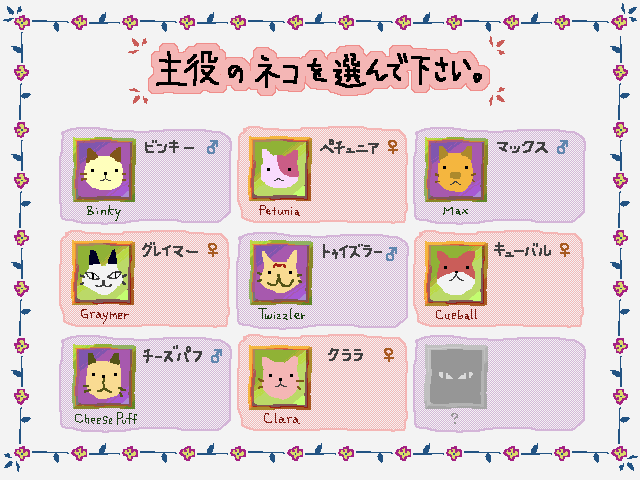
A video game is maybe the least likely kind of merchandise they could have created, and the genre of that game is even less likely. It's easy to imagine that a video game based on the Jingle Cats albums would be a music game, or maybe a virtual pet game, but somehow it's neither of these things. It's more of a cross between a puzzle game and a virtual pet game. The player takes on the role of the caretaker of Jingle Cats House, with one important duty: the house's nine cats have to get along. They have to be friends.
However, anyone who's ever had a cat knows that the single hardest thing to do is to get a cat to do something they don't want to do. And so, the player's role isn't just to get the cats to become friends, but to find subtle ways to trick the cats into becoming friends.
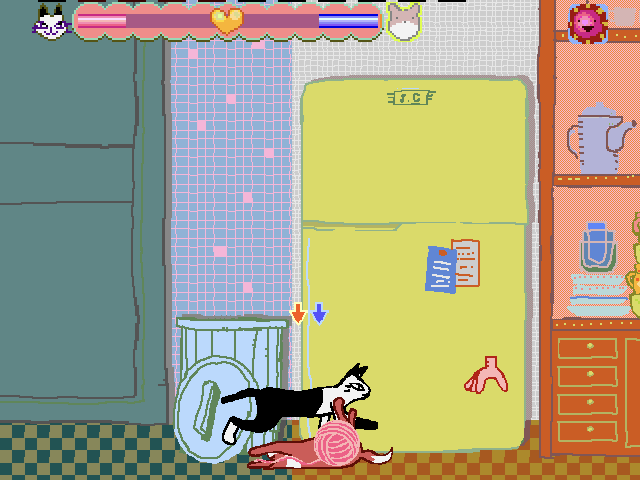
Each level, the player is given the chance to pick two cats who haven't made friends yet and put them in the house together. The cats have individual personalities and preferences, which are explained in some cute and quite flavourful descriptions when the player is choosing them; while the player has quite a few choices of pairings in any given stage, not all possible pairings are as compatible as each other and a large part of the strategy involves picking cats who are most likely to share something in common. Once the player has chosen cats and begun a stage, they wander freely and do whatever they feel like... until the player starts interfering. At the top of the screen, the cats have individual "love" meters representing their affection for the other cat; the player's goal is to get both of these as high as they can so that they can then become friends. Left to their own devices, the cats aren't likely to become friends; they might wander around, ignore reach other, or fight, but they won't proactively learn to tolerate each other. Instead, the player needs to inject themselves into the situation—playing with one cat while another is nearby, feeding them in close proximity to each other, finding favourite toys and stationing both cats next to each other. Slowly but surely, as the player finds ways to get them to tolerate each other, they'll even learn to like each other.
Once the player thinks they're ready, they can trigger a friendship "attack". As the attack begins, the game cuts to a short cutscene where the cats either become fast friends... or hiss at each other, depending on whether they were actually ready or not. Become friends, and it's off to the next stage with a new set of cats. Fail, and they simply return to the level to keep trying without any penalty.
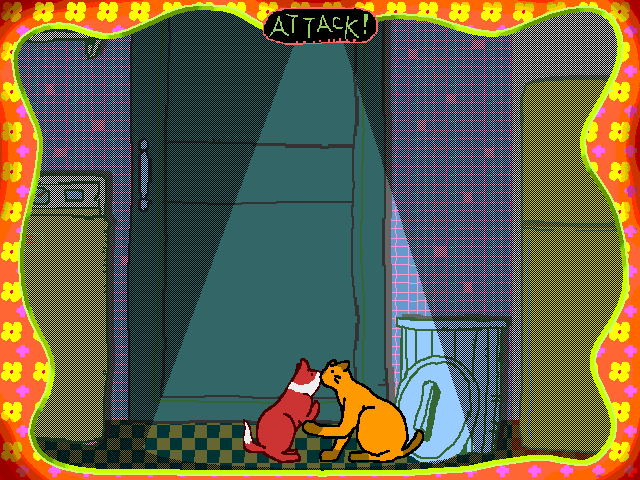
After the first stage, the game begins throwing an extra complication at the player: there are extra cats. The second stage features one extra cat, chosen from one of the two the player had chosen in the first stage; the third stage then features two extra cats; and so on. The more cats, the harder the game becomes. The player can sort of force positive interactions between just two cats just by constantly keeping them close to each other if there's only two, but as the number of cats grow, the distractions do too. There's no "point" or "utility" to the wrong pair of cats becoming friends after all! You have a goal to meet, and so extra cats are purely agents of chaos.
The theming is, honestly, perfect. As an AV Club reviewer also points out[2], this genuinely is true to the experience of having a cat, and of having a goal while struggling to have your cat agree that your goal is at all important. Likewise, the only thing less cooperative than a cat who doesn't want to do something is several cats who don't want to do something. Filling your house with cats is the worst way to get anything at all done, which is why it's the perfect subject for a puzzle game.
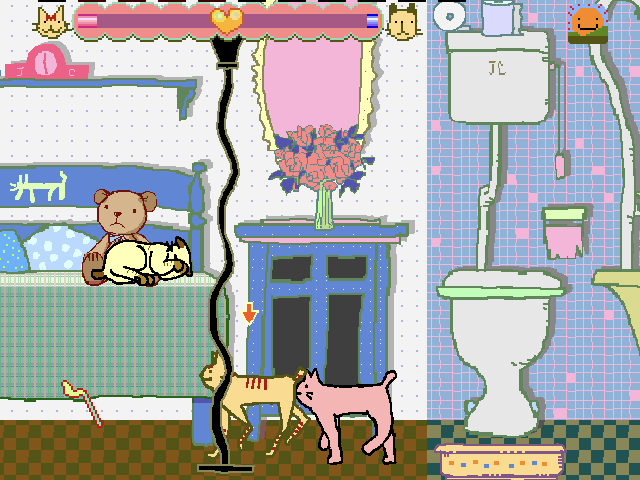
The cat designs are delightful, strangely-proportioned spindley-legged cartoon creatures who, in all their weirdness, feel exactly like the concept of a cat. Their designs and their weird movements very much sell the chaos that's happening around them. The cats are named after Jingle Cats creator Mike Spalla's real cats[3], though their cartoon designs are based more directly on cartoon versions of those cats who had appeared in Japanese versions of the Jingle Cats albums as early as 1995[4]. The original cats from the Japanese album covers are cute, but the game's designs add just that extra bit of scrungliness that truly makes them. It's better that they're weird creatures who don't quite walk right.
The game was developed by Vantan International, an arm of longtime vocational school Vantan Game Academy. Without context, it's hard to tell if this was a student project; Vantan International may have been a work experience program that paired students with experienced designers, similar to the environment at Namco's game school that produced Katamari Damacy, or it may simply have been a professional studio that was open to hiring its parent company's own students. The artwork, and Jingle Cats's take on the characters, come thanks to Vantan employee Yo Murashima[5] whose distinctive quirky cartoon designs also appeared in the Game-Ware magazine series, the Saturn Music School edutainment discs, and the later PlayStation game Ten Made Jack.
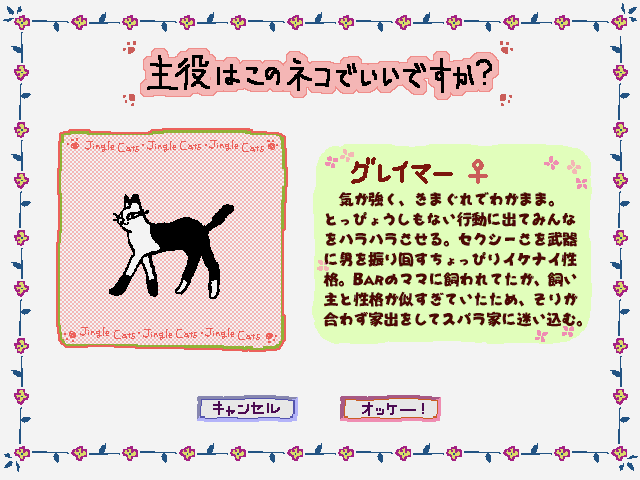
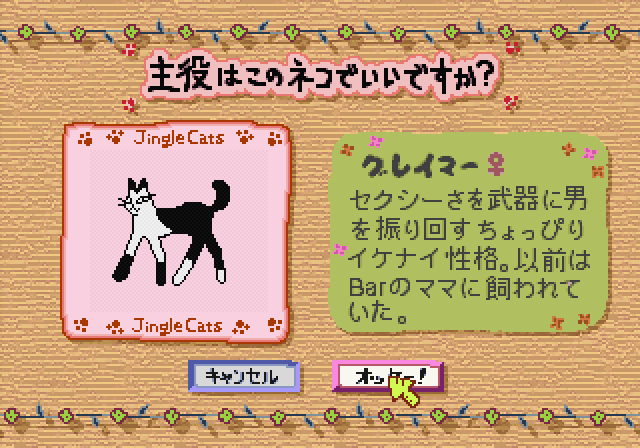
Jingle Cats was released for both computers and for the PlayStation game console. These versions are mostly the same, featuring the same cats and the same core gameplay. Some evidence suggests the Mac and Windows computer versions were probably the lead platforms. The internal file build dates come about four months prior to the PlayStation version and their cutscenes and graphics contain details that are illegible on the PlayStation, suggesting that artwork was created at high resolution first and only later converted to the PlayStation's lower resolution. Perhaps most tellingly, the PlayStation version has about half the text of the computer versions—in order to keep font size large and legible, the PlayStation version eliminates about half of the text in each cat's biography in the character select menu.

One thing the PlayStation version does feature, however, is singing. Being based on a novelty album series, it's no surprise that all versions of Jingle Cats feature music. On Mac and Windows, completing a level rewards the player with a recording of one of the Jingle Cats pop music covers, while artwork of the cats scrolls by on the screen. The PlayStation version, meanwhile, features custom animations of the cats singing the song with some very charmingly weird mouth animations. There's a difference, it turns out, between just hearing music and seeing it be performed even when it's exactly the same recording, and there's certainly a reason why the cat concert scenes are the best-known element from the PlayStation version.
With or without singing, though, this game is a surreal delight—something strange and cute, and far, far better than it ever even needed to be.
1. About Us. (2013, December 16). JINGLE CATS MUSIC. https://web.archive.org/
2. Agnello, A. J. (2016, April 5). Jingle Cats can be as surreal as actually living with a cat. The A.V. Club. https://www.avclub.com/
3. It’s the Cats’ Meows: Mike Spalla’s new Christmas compact disc features felines yowling Yuletide favorites. (1993, November 19). Los Angeles Times. https://www.latimes.com/
4. ジングルドッグ. (1995). クリスマスパーティ [CD]. Coming Records. ↩
5. Yo Murashima. (n.d.). MobyGames. Retrieved September 30, 2024, from https://www.mobygames.com/person/34724/yo-murashima/ ↩